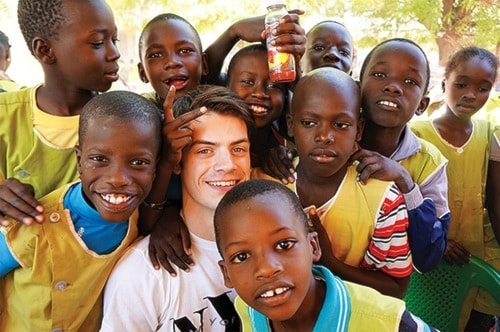A trip to West Africa has left several Nanaimo District Secondary School students changed.
Seven francophone students from Nanaimo were part of an 18-day humanitarian trip to Senegal organized by the provincial Conseil Scholaire Francophone school district’s distance learning school.
The students delivered supplies and books they spent the past year collecting to schools, worked in an orphanage and visited small villages, using M’bour city as a base.
Senior students Lucas Pallard, Catherine Charlebois and Sebastien Legault were expecting life to be different in Africa, but that realization didn’t fully prepare them for what they experienced.
The students saw people in poverty – people would burn garbage on city streets to ward off mosquitoes, women with giant bags would pick through the garbage for clothing for their families and many had little in terms of material possessions compared with Canadians. But they were happy people who worked with what they had and improvised when they needed to, said Pallard.
“They’d never known anything different,” he said. “They’re not malnourished. They really had ingenious ways of making things work.”
Pallard saw pots and pans made out of recycled aluminum and children playing made-up games with whatever is on hand, including old tires.
In Senegal, life is more about connections with the people around you than the stuff you have, added Charlebois.
The most poignant part of the trip for her was visiting the orphanage, where there were 37 babies or children per room with about five attendants looking after the children in each room.
Some of the children have parents, but the family already has too many children to support and so they end up in the orphanage.
“You walked in and the cribs were one after the other,” said Charlebois. “There’s so many of them. They saw you and wanted to be picked up. They didn’t want to be put down. And you didn’t want to put them down. There’s the attendants, but they can’t handle that many kids and give them the love they need.”
The students went to the orphanage three times, but Charlebois chose to remain behind the second two times because the experience was too heartbreaking for her.
The highlight of the trip for Legault was visiting the schools, where he said the kids would run up to meet the Canadian students.
“They all wanted to meet us and know our names,” he said, adding that class sizes were between 50-60 students with just one teacher in the room and technology was minimal – one school had a computer lab, but the computers were old and teachers used various recycled materials as blackboards.
The students were overwhelmed at times by the heat – each day, temperatures rose above 30 C – and amazed at the languages people knew – most spoke Wolof and French, and English and Spanish were also taught in schools.
Almost all of the students on the trip got sick at some point and they learned that timelines are different than in Canada – one day the person who was supposed to bring the students lunch arrived two hours later than promised.
Pallard said the slower pace of life was nice, but at the same time students were anxious to get moving, as they were only there for a few weeks.
On students’ minds more often now is ensuring they are not wasteful with food or electricity – one of the villages they visited in Senegal didn’t have electricity or running water and while people weren’t starving, there was less variety in the diets of the Senegalese people.
Charlebois said the first thing she did when she arrived home was have a glass of milk, as all the students had access to was powdered milk in Senegal.
